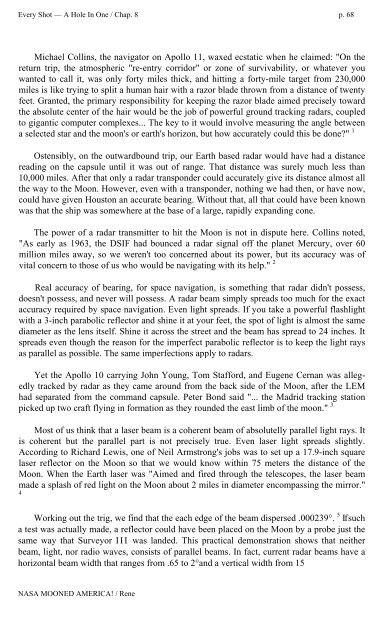Rene-NASA-Mooned-America
Rene-NASA-Mooned-America
Rene-NASA-Mooned-America
You also want an ePaper? Increase the reach of your titles
YUMPU automatically turns print PDFs into web optimized ePapers that Google loves.
Every Shot — A Hole In One / Chap. 8 p. 68<br />
Michael Collins, the navigator on Apollo 11, waxed ecstatic when he claimed: "On the<br />
return trip, the atmospheric "re-entry corridor" or zone of survivability, or whatever you<br />
wanted to call it, was only forty miles thick, and hitting a forty-mile target from 230,000<br />
miles is like trying to split a human hair with a razor blade thrown from a distance of twenty<br />
feet. Granted, the primary responsibility for keeping the razor blade aimed precisely toward<br />
the absolute center of the hair would be the job of powerful ground tracking radars, coupled<br />
to gigantic computer complexes... The key to it would involve measuring the angle between<br />
a selected star and the moon's or earth's horizon, but how accurately could this be done" 1<br />
Ostensibly, on the outwardbound trip, our Earth based radar would have had a distance<br />
reading on the capsule until it was out of range. That distance was surely much less than<br />
10,000 miles. After that only a radar transponder could accurately give its distance almost all<br />
the way to the Moon. However, even with a transponder, nothing we had then, or have now,<br />
could have given Houston an accurate bearing. Without that, all that could have been known<br />
was that the ship was somewhere at the base of a large, rapidly expanding cone.<br />
The power of a radar transmitter to hit the Moon is not in dispute here. Collins noted,<br />
"As early as 1963, the DSIF had bounced a radar signal off the planet Mercury, over 60<br />
million miles away, so we weren't too concerned about its power, but its accuracy was of<br />
vital concern to those of us who would be navigating with its help." 2<br />
Real accuracy of bearing, for space navigation, is something that radar didn't possess,<br />
doesn't possess, and never will possess. A radar beam simply spreads too much for the exact<br />
accuracy required by space navigation. Even light spreads. If you take a powerful flashlight<br />
with a 3-inch parabolic reflector and shine it at your feet, the spot of light is almost the same<br />
diameter as the lens itself. Shine it across the street and the beam has spread to 24 inches. It<br />
spreads even though the reason for the imperfect parabolic reflector is to keep the light rays<br />
as parallel as possible. The same imperfections apply to radars.<br />
Yet the Apollo 10 carrying John Young, Tom Stafford, and Eugene Cernan was allegedly<br />
tracked by radar as they came around from the back side of the Moon, after the LEM<br />
had separated from the command capsule. Peter Bond said "... the Madrid tracking station<br />
picked up two craft flying in formation as they rounded the east limb of the moon." 3<br />
Most of us think that a laser beam is a coherent beam of absolutelly parallel light rays. It<br />
is coherent but the parallel part is not precisely true. Even laser light spreads slightly.<br />
According to Richard Lewis, one of Neil Armstrong's jobs was to set up a 17.9-inch square<br />
laser reflector on the Moon so that we would know within 75 meters the distance of the<br />
Moon. When the Earth laser was "Aimed and fired through the telescopes, the laser beam<br />
made a splash of red light on the Moon about 2 miles in diameter encompassing the mirror."<br />
4<br />
Working out the trig, we find that the each edge of the beam dispersed .000239°. 5 If such<br />
a test was actually made, a reflector could have been placed on the Moon by a probe just the<br />
same way that Surveyor III was landed. This practical demonstration shows that neither<br />
beam, light, nor radio waves, consists of parallel beams. In fact, current radar beams have a<br />
horizontal beam width that ranges from .65 to 2°and a vertical width from 15<br />
<strong>NASA</strong> MOONED AMERICA! / <strong>Rene</strong>


